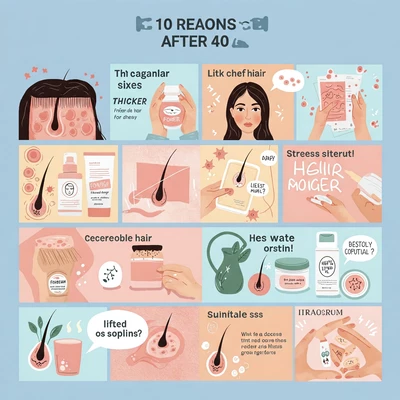Thinning Hair After 40: Top 10 Reasons & Fixes for 2025
Noticing your hair feels less voluminous after 40 is a common concern in 2025. Several factors contribute to this change, but understanding them is the first step towards restoring fuller, healthier hair. This comprehensive guide explores the top 10 reasons for hair thinning after 40 and provides effective solutions to address each cause, empowering you to regain confidence in your locks.

The Hair Life Cycle Shift: Understanding Thinning After 40
Hair growth follows a cycle with phases of growth (anagen), transition (catagen), and rest (telogen), followed by shedding. As we age, this cycle can shorten, leading to slower growth and more hair follicles entering the resting and shedding phases. Additionally, the diameter of individual hair strands can decrease, resulting in an overall thinner appearance.
Top 10 Reasons for Hair Thinning After 40 in 2025:
-
Hormonal Fluctuations: This is a major culprit, particularly for women experiencing perimenopause and menopause. Declining estrogen levels can lead to a decrease in hair density. Men may also experience changes in testosterone levels affecting hair growth.
- The Fix: Consult a doctor about hormone replacement therapy or explore natural hormone-balancing supplements. Consider hair products specifically formulated for hormonal hair loss.
-
Genetics (Androgenetic Alopecia): Also known as male or female pattern baldness, this hereditary condition can become more noticeable after 40. It causes hair follicles to shrink and produce finer, shorter hairs.
- The Fix: Explore FDA-approved treatments like minoxidil and finasteride (for men). Low-level laser therapy (LLLT) and platelet-rich plasma (PRP) therapy are also options.
-
Chronic Stress: High stress levels can disrupt the hair growth cycle, leading to telogen effluvium – temporary hair shedding. Chronic stress can prolong this shedding and contribute to overall thinning.
- The Fix: Implement stress-management techniques like yoga, meditation, and regular exercise. Ensure you're getting enough sleep.
-
Nutrient Deficiencies: Inadequate intake of essential vitamins and minerals like iron, zinc, biotin, and vitamin D can impact hair health and contribute to thinning.
- The Fix: Follow a balanced diet rich in fruits, vegetables, and lean protein. Consider supplements after consulting a doctor about any deficiencies.
-
Medical Conditions: Certain medical conditions like thyroid disorders, autoimmune diseases, and scalp infections can cause or exacerbate hair thinning.
- The Fix: Seek diagnosis and treatment for any underlying medical conditions. Addressing the root cause can often improve hair health.
-
Medications: Some medications, including certain antidepressants, blood thinners, and beta-blockers, can have hair thinning as a side effect.
- The Fix: Discuss any medications you're taking with your doctor to see if hair thinning is a potential side effect and if alternative options are available.
-
Harsh Hair Treatments and Styling: Frequent use of heat styling tools, chemical treatments (perms, relaxers, dyes), and tight hairstyles can damage the hair shaft, leading to breakage and the appearance of thinner hair.
- The Fix: Minimize heat styling and chemical treatments. Opt for gentler styling methods and avoid tight hairstyles that pull on the scalp. Use heat protectants and deep conditioners.
-
Scalp Health Issues: A dry, flaky, or inflamed scalp can hinder healthy hair growth. Conditions like seborrheic dermatitis or psoriasis can contribute to thinning.
- The Fix: Maintain good scalp hygiene with regular washing using a gentle shampoo. Consider using specialized shampoos for scalp conditions and explore scalp treatments like oils or serums.
-
Poor Circulation: Reduced blood flow to the scalp can limit the delivery of essential nutrients to hair follicles, potentially impacting hair growth and thickness.
- The Fix: Incorporate regular exercise to improve overall circulation. Scalp massage can also help stimulate blood flow to the hair follicles.
-
Aging of Hair Follicles: As we age, hair follicles naturally become less efficient at producing thick, pigmented hair. This intrinsic aging process contributes to finer, thinner, and sometimes graying hair.
- The Fix: While you can't stop the aging process, you can focus on maintaining the health of your existing follicles with proper care and targeted treatments.
Revitalizing Your Locks: How to Fix Thinning Hair After 40 in 2025:
Addressing hair thinning after 40 requires a multi-pronged approach that tackles the underlying causes. Here are some key strategies for 2025:
- Establish a Gentle Hair Care Routine: Use sulfate-free shampoos and moisturizing conditioners. Handle your hair gently when washing and drying.
- Incorporate Scalp Care: Regularly massage your scalp to stimulate blood flow. Consider using scalp scrubs or treatments to remove buildup and promote a healthy environment for hair growth.
- Nourish From Within: Ensure a balanced diet rich in hair-healthy vitamins and minerals. Consider supplements if you have deficiencies.
- Minimize Damage: Reduce heat styling, chemical treatments, and tight hairstyles.
- Explore Topical Treatments: Over-the-counter minoxidil can help stimulate hair growth for some individuals.
- Consider Professional Treatments: Consult a dermatologist about prescription medications, LLLT, PRP therapy, or hair transplantation options.
- Manage Stress: Prioritize stress-reducing activities and ensure adequate sleep.
- Be Patient: Hair regrowth takes time. Be consistent with your chosen treatments and allow several months to see noticeable results.
- Embrace Volumizing Products: Use volumizing shampoos, conditioners, mousses, and sprays to create the illusion of thicker hair.
- Consider Hair Extensions or Wigs: These can provide an immediate solution for adding volume and length while you address the underlying causes of thinning.
Conclusion: Embracing Fuller Hair Health After 40 in 2025
Experiencing hair thinning after 40 is a common but often distressing concern. By understanding the potential underlying reasons and implementing targeted solutions, you can take proactive steps to improve your hair health and restore a fuller, more vibrant appearance in 2025. Remember that a combination of gentle care, addressing internal factors, and exploring appropriate treatments can make a significant difference in the health and thickness of your hair, allowing you to feel confident and comfortable with your look.
|
